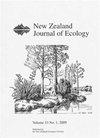Factors limiting kererū (Hemiphaga novaeseelandiae) populations across New Zealand
IF 1.4
3区 环境科学与生态学
Q3 ECOLOGY
引用次数: 3
Abstract
Kererū declined rapidly following European settlement in New Zealand, and they remain at a reduced density. We assessed three sources of information to test the hypothesis that predation by introduced mammals and abundance of food resources are the two major factors determining kererū abundance across New Zealand. First, we reviewed the literature on factors affecting the vital rates of kererū. This analysis showed that predation is the cause of most nest failures and deaths in kererū. Second, we examined data from a major database of bird sanctuary outcomes across New Zealand to evaluate long-term responses of kererū to intensive pest control at local scales. Kererū detections did not always increase following predator control, which suggests that food supply or forest area may be more important limiting factors at some sanctuaries. Third, to understand the factors underlying temporal and spatial kererū distribution patterns at a national scale, we assessed changes and patterns in kererū local occupancy through time using data from the 1969–1979 and 1999–2004 editions of the Atlas of Bird Distribution in New Zealand. Specifically, we asked (1) whether there have been declines in kererū occupancy between the two Atlases, and (2) how patterns of kererū occupancy relate to indigenous forest cover, temperature, urbanisation, and forest type (podocarp or beech dominated). Kererū occupancy remained stable across the North Island between the two time periods but declined in the South Island. Across both islands and time periods, kererū occupancy decreased significantly as forest cover decreased, which suggests that forest availability is still a major limiting factor across some parts of New Zealand. Overall, our results support previous studies showing that predation by introduced mammals is the primary limiting factor for kererū in forests, but also highlight the importance of forest area and food supply for kererū recovery.限制新西兰kerkeri(新翅虫科)种群的因素
在欧洲人定居新西兰之后,kererka的数量迅速减少,并且它们的密度仍然很低。我们评估了三个信息来源,以验证引入哺乳动物的捕食和食物资源的丰富度是决定新西兰kererki丰度的两个主要因素的假设。首先,我们回顾了影响kererki的因素的文献。这一分析表明,捕食是导致kererka大多数巢巢失败和死亡的原因。其次,我们检查了来自新西兰鸟类保护区结果的一个主要数据库的数据,以评估kererka对地方范围内强化害虫控制的长期反应。在捕食者控制之后,kererka的探测并不总是增加,这表明食物供应或森林面积可能是一些保护区更重要的限制因素。第三,利用新西兰鸟类分布图集(Atlas of Bird distribution in New Zealand) 1969-1979年和1999-2004年两版的数据,评估了kererka本地占用率随时间的变化和模式,以了解全国范围内kererka的时空分布格局。具体来说,我们提出了以下问题:(1)两个地图集之间kererka的占用率是否有所下降;(2)kererka的占用模式与原始森林覆盖、温度、城市化和森林类型(以podocarp或beech为主)之间的关系。在这两个时间段内,北岛的kererka入住率保持稳定,但南岛的kererka入住率有所下降。在岛屿和时间段内,随着森林覆盖的减少,kererki的占用率显著下降,这表明森林可用性仍然是新西兰某些地区的主要限制因素。总体而言,我们的研究结果支持了先前的研究结果,即引入哺乳动物的捕食是kererka在森林中的主要限制因素,但也强调了森林面积和食物供应对kererka恢复的重要性。
本文章由计算机程序翻译,如有差异,请以英文原文为准。
求助全文
约1分钟内获得全文
求助全文
来源期刊

New Zealand Journal of Ecology
环境科学-生态学
CiteScore
3.00
自引率
12.50%
发文量
35
审稿时长
>36 weeks
期刊介绍:
The New Zealand Journal of Ecology is a biannual peer-reviewed journal publishing ecological research relevant to New Zealand/Aotearoa and the South Pacific. It has been published since 1952 (as a 1952 issue of New Zealand Science Review and as the Proceedings of the New Zealand Ecological Society until 1977). The Journal is published by the New Zealand Ecological Society (Inc.), and is covered by Current Contents/Agriculture, Biology and Environmental Science, GEOBASE, and Geo Abstracts.
 求助内容:
求助内容: 应助结果提醒方式:
应助结果提醒方式:


